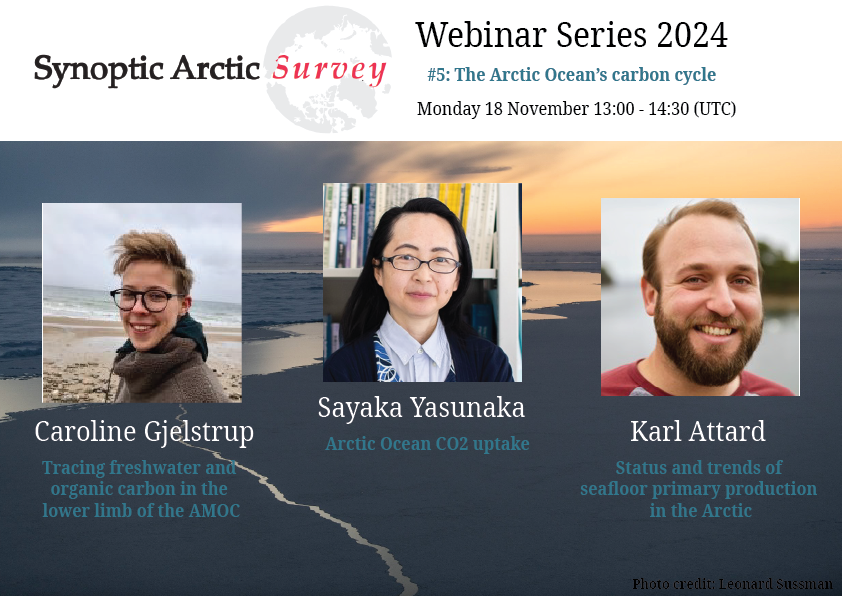Zoom webinar on Monday 18 November, 13:00 – 14:30 (UTC)

The Synoptic Arctic Survey (SAS) aims to map the present states and ongoing changes of the Arctic Ocean ecosystem, carbon cycle and associated hydrography. It does so by enhancing ongoing ocean monitoring with ship-based measurements.
This webinar showcases recent updates on carbon exchange between the different pools in the carbon cycle of the Arctic Ocean. Marine carbon originates from river run-off (terrestrial) or air-sea fluxes (atmospheric) and is exported to the deep through large-scale currents where it feeds benthic organisms, if there is sufficient light and other nutrients. There will be three solicited talks with room for questions and discussions:
- Caroline Gjelstrup – Postdoc. at DTU Aqua, Denmark
- Tracing the origins and fate of freshwater and organic carbon in the lower limb of the AMOC
- Sayaka Yasunaka – Professor at Tohoku University, Japan
- Arctic Ocean CO2 uptake
- Karl Attard – Associate professor at University of Southern Denmark, Denmark
- Seafloor primary production in a changing Arctic Ocean: Status and trends
The webinar will take place in Zoom. If you would like to join the webinar, please register to receive the meeting link:
https://skjemaker.app.uib.no/view.php?id=18080617
Abstracts of presentations
Tracing the origins and fate of freshwater and organic carbon in the lower limb of the AMOC – by Caroline Gjelstrup (DTU Aqua, Denmark)
Freshwater originating from the central Arctic Ocean participates in the globally important Atlantic Meridional Overturning Circulation (AMOC). However, the origins of this freshwater contribution are currently unknown. Identifying and quantifying these sources is essential to understanding how Arctic freshwater influences the overturning circulation. Over the two past decades, dissolved organic matter (DOM) has emerged as a promising tracer of Arctic waters, providing insights into the origins, distribution and transformation of freshwater and carbon in the central Arctic Ocean. Here, we expand on this approach and use high-resolution, in-situ observations of dissolved organic matter (DOM) fluorescence to trace the origins of freshwater and organic carbon in the densest component of the AMOC, namely the Denmark Strait Overflow Water (DSOW). We find a distinct terrestrial DOM signal in DSOW that can be traced upstream to the Siberian shelves in the central Arctic Ocean. This implies a riverine origin of freshwater in DSOW, and we estimate a 0.94 % contribution of Siberian Shelf water to DSOW. Modelling confirms the large-scale connectivity between high Arctic rivers and the deep water in the AMOC inferred from observations. The results demonstrate biogeochemical connectivity on large regional scales and offers a potential to monitor freshwater and organic carbon export in the AMOC.
Further reading:
Arctic Ocean CO2 uptake – by Sayaka Yasunaka (Tohoku University, Japan)
The Arctic Ocean is at present a net sink for atmospheric CO2 mainly due to the intense cooling of the inflowing waters from the Atlantic and the Pacific. Global warming is amplified in the Arctic Ocean and it experiences a rapid retreat of sea ice. As a contribution to the Regional Carbon Cycle Assessment and Processes phase 2 (RECCAP2) project, we presented synthesized estimates of the Arctic Ocean CO2 uptake and their uncertainties from estimates obtained using different methods. Almost all estimates suggest that the Arctic Ocean was a net sink of CO2 from 1985 to 2018. The CO2 uptake is strong in late summer and early autumn and weak in winter, corresponding to the seasonal variation of sea ice. CO2 uptake has increased in recent years, especially in regions that have experienced sea ice loss. However, the uncertainty remains large especially in the pCO2w estimates.
Further reading:
An Assessment of CO2 Uptake in the Arctic Ocean From 1985 to 2018 – Global Biogeochemical Cycles
Seafloor primary production in the Arctic: Status and trends – by Karl Attard (University of Southern Denmark)
Phytoplankton and sea ice algae are traditionally considered the main primary producers in the Arctic. This presentation explores a third, lesser-known group of Arctic marine primary producers: microphytobenthos, seaweeds, and seagrasses, collectively termed seafloor (or benthic) primary producers. Our recent study estimates that they could contribute around one-third of Arctic marine primary production. As sea ice continues to decline, they are expected to proliferate further into the Arctic. However, reduced water transparency in certain regions of the Arctic might limit their expansion, suggesting complex impacts of climate change on Arctic light availability and marine primary production.
Further reading:

